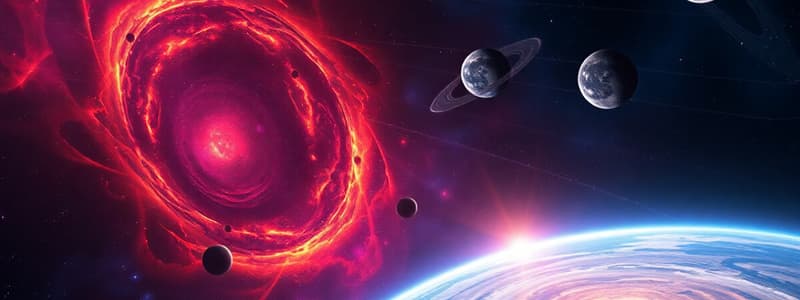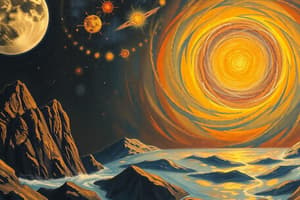Podcast
Questions and Answers
What major elements were produced during the big bang?
What major elements were produced during the big bang?
- Oxygen, carbon, and nitrogen
- Hydrogen, helium, and lithium (correct)
- Gold, silver, and platinum
- Silicon, iron, and magnesium
What process generates heavier elements after the big bang?
What process generates heavier elements after the big bang?
- Condensation in interstellar dust
- Nuclear fusion reactions in stars (correct)
- Chemical reactions on planetary surfaces
- Nuclear fission in supernovae
What led to the formation of the moon?
What led to the formation of the moon?
- Dust accumulation from solar winds
- Volcanic activity on Earth
- Asteroids colliding with Earth
- A collision with a Mars-sized planet (correct)
Why are rocky planets found closer to the Sun in our solar system?
Why are rocky planets found closer to the Sun in our solar system?
What contributed to the composition of Earth's atmosphere?
What contributed to the composition of Earth's atmosphere?
What is the primary composition of the terrestrial planets?
What is the primary composition of the terrestrial planets?
Which two planets have unusual rotational characteristics compared to the rest of the planets?
Which two planets have unusual rotational characteristics compared to the rest of the planets?
What is the largest dwarf planet discovered, which is comparable in size to Pluto?
What is the largest dwarf planet discovered, which is comparable in size to Pluto?
What is the region beyond Neptune where most comets form?
What is the region beyond Neptune where most comets form?
What effect did the discovery of Eris have on Pluto's planetary status?
What effect did the discovery of Eris have on Pluto's planetary status?
What is referred to as the cosmic microwave background (CMB)?
What is referred to as the cosmic microwave background (CMB)?
Which observation led Edwin Hubble to conclude that the universe is expanding?
Which observation led Edwin Hubble to conclude that the universe is expanding?
How do we see distant astronomical objects as they appeared in the past?
How do we see distant astronomical objects as they appeared in the past?
What elements were primarily produced from the early collisions in the universe?
What elements were primarily produced from the early collisions in the universe?
What scientific concept explains the change in wavelength of light from galaxies moving away from us?
What scientific concept explains the change in wavelength of light from galaxies moving away from us?
Which of the following criteria must an object meet to be classified as a planet?
Which of the following criteria must an object meet to be classified as a planet?
Why is Pluto classified as a dwarf planet?
Why is Pluto classified as a dwarf planet?
Which of the following is true about the moons of the planets?
Which of the following is true about the moons of the planets?
What are comets primarily composed of?
What are comets primarily composed of?
In a scale model of the solar system, how far is Jupiter from the scaled-down Sun?
In a scale model of the solar system, how far is Jupiter from the scaled-down Sun?
What type of planets are classified as Jovian planets?
What type of planets are classified as Jovian planets?
What visual phenomena occur when cosmic dust enters Earth's atmosphere?
What visual phenomena occur when cosmic dust enters Earth's atmosphere?
What is the primary reason for the complexity in the ring systems of the giant planets?
What is the primary reason for the complexity in the ring systems of the giant planets?
What is the primary composition of Jupiter and Saturn?
What is the primary composition of Jupiter and Saturn?
What process helps to separate a planet's interior into different layers based on composition?
What process helps to separate a planet's interior into different layers based on composition?
Which planet is likely to have the highest average surface temperature?
Which planet is likely to have the highest average surface temperature?
What characteristics do the moons Ganymede, Callisto, and Titan share?
What characteristics do the moons Ganymede, Callisto, and Titan share?
Why does Pluto have significantly lower surface temperatures compared to Mercury?
Why does Pluto have significantly lower surface temperatures compared to Mercury?
What does the term 'oxidized' refer to regarding terrestrial planets?
What does the term 'oxidized' refer to regarding terrestrial planets?
What distinguishes the cores of Uranus and Neptune from those of Jupiter and Saturn?
What distinguishes the cores of Uranus and Neptune from those of Jupiter and Saturn?
Study Notes
The Big Bang
- The universe began 13.77 billion years ago.
- The big bang involved the expansion of matter, energy, and space from a single point.
- The big bang created hydrogen, helium, and lithium.
- Evidence for the big bang is cosmic microwave background radiation, which is the "afterglow" from the early universe, and red-shifted light from distant galaxies, which tell us that these galaxies are moving away from us.
Our Planetary System
- The solar system formed 4.5 billion years ago from a cloud of gas and dust.
- The Sun formed at the center of the cloud, and planets formed in the disk around the sun.
- The solar system consists of the Sun, eight planets, their moons, asteroids, comets, and dust.
- Rocky planets (Mercury, Venus, Earth, and Mars) are closer to the Sun.
- Ice and gas giants (Jupiter, Saturn, Uranus, and Neptune) are further from the Sun.
Planetary Formation
- The formation of planets is a process of accretion.
- Dust and gas in the protoplanetary disk clumped together to form planetesimals.
- Planetesimals grew by colliding and merging.
- The final stage of planetary formation involved the sweeping up of remaining material in the disk.
Earth's Formation and Evolution
- Radioactive decay, collisions with bodies from space, and gravitational compression heated early Earth.
- The intense heat caused Earth to differentiate, with the denser materials (iron and nickel) sinking to form the core, and the lighter silicate melts forming the mantle and crust.
- A large impact event is thought to have created the Moon.
The Search for Exoplanets
- Over 12 exoplanets have been discovered that are similar in size to Earth and within the habitable zone of their stars.
- It is thought that these planets are rocky worlds like Earth, but the compositions of these planets are not known for certain.
Giant Planets
- Jupiter and Saturn are composed primarily of hydrogen and helium, with 75% hydrogen and 25% helium by mass.
- The gas is compressed in the interior of Jupiter and Saturn until the hydrogen becomes liquid, making them "liquid planets".
- Jupiter and Saturn have cores composed of heavier rock, metal, and ice, but these regions cannot be seen directly.
- Uranus and Neptune are smaller than Jupiter and Saturn but also have cores of rock, metal, and ice.
- Uranus and Neptune have smaller atmospheres in proportion to their cores, as they were less efficient at attracting hydrogen and helium gas.
- The giant planets are dominated by hydrogen and its compounds, including water (H2O).
Terrestrial Planets
- The terrestrial planets are much smaller than the giants and composed primarily of rocks and metals.
- Silicates, made of silicon and oxygen, are the most abundant rocks, while iron is the most common metal.
- Mercury has the highest proportion of metals, while the Moon has the lowest.
- Earth, Venus, and Mars have roughly the same bulk composition, with one-third iron-nickel or iron-sulfur and two-thirds silicates.
- The terrestrial planets have a central core of dense metals and lighter silicates near the surface, suggesting they were once hot enough to melt.
- Differentiation is the process by which gravity separates a planet’s interior into layers of different compositions and densities.
Moons, Asteroids, and Comets
- Earth’s Moon is similar to the terrestrial planets in composition and structure.
- Most moons are in the outer solar system and have compositions similar to giant planet cores.
- The three largest moons (Ganymede, Callisto, Titan) are composed of half frozen water and half rocks and metals.
- Most moons differentiated during formation with cores of rock and metal and icy upper layers and crusts.
- Most asteroids and comets were never heated to the melting point, but some larger asteroids, like Vesta, are differentiated.
Surface Temperatures
- The farther a planet or moon is from the Sun, the cooler its surface.
- Surface temperature decreases approximately in proportion to the square root of the distance from the Sun.
- A planet’s atmosphere can significantly influence its surface temperature.
- Earth is the only planet where surface temperatures generally lie between the freezing and boiling points of water.
Dating Planetary Surfaces
- Astronomers estimate the age of planetary surfaces by counting impact craters.
- Crater counts can provide clues about how regions on a world evolved.
- The more heavily cratered terrain on a world is generally older.
- Scientists use radioactive decay to measure the age of individual rocks.
- Radioactive decay provides accurate nuclear clocks, allowing scientists to estimate the age of rocks.
- The ages of Earth and the Moon have been determined to be roughly 4.5 billion years old.
Origin of the Solar System
- The solar system formed from a spinning cloud of gas and dust called the solar nebula.
- The composition of the planets suggests different formation processes:
- Giant planets formed from mostly hydrogen and helium.
- Terrestrial planets formed from heavier elements, as lighter elements evaporated in the inner solar system.
- Circumstellar disks surrounding young stars are evidence of planet formation in other systems.
- Planetesimals are small objects that formed from gas and dust in circumstellar disks.
- Planetesimals collided and gathered together to form the planets.
- The early solar system was violent, with planetesimals crashing into one another and disrupting planets.
- The random collisions of planetesimals could explain some exceptions to the expected patterns in the solar system.
Formation of the Solar System
- The Sun and planets formed from a spinning cloud of gas and dust known as the solar nebula.
- Circumstellar disks, observed around other stars, provide evidence for the formation of solar systems similar to our own.
- within the solar nebula, small bodies called planetesimals aggregated to form larger bodies, eventually leading to the planets and moons.
- The remaining planetesimals, now known as comets and asteroids, provide insights into the early stages of solar system formation.
- Several exoplanet systems, while sharing similar origins, have evolved along vastly different paths, highlighting the diversity of planetary system development.
Planetary Origins
- Planets and moons formed from the gradual accumulation of planetesimals within the solar nebula.
- Planetesimals, smaller objects in the early solar system, attracted other planetesimals through gravity, leading to the formation of larger bodies.
- This process of accretion, where particles gradually accumulate over time, led to the creation of the planets we know today.
Studying That Suits You
Use AI to generate personalized quizzes and flashcards to suit your learning preferences.
Description
Explore the origins of the universe with this quiz on the Big Bang and the formation of our solar system. Discover the key events that shaped the cosmos 13.77 billion years ago, and learn how planets formed from a cloud of gas and dust. Test your knowledge on cosmic phenomena and planetary structures.




